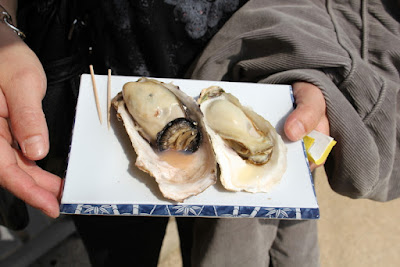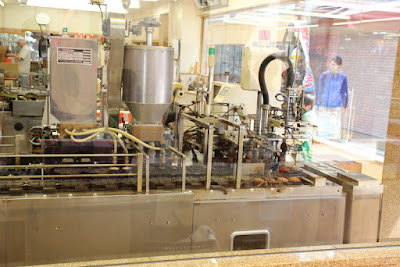A few years back, I bought a cheap $169 Squier Stratocaster for my wife and I to share as a "practice guitar" - she doesn't have another guitar with a tremolo and I just wanted a guitar I could beat up and not worry about.
We've never really been all that happy with it, though. Like a lot of cheap guitars, it looks and feels good when you first pick it up but it's just missing something, and I don't know what... that thing that makes you love a guitar, I guess, whatever that is. Mojo. It kind of looks and feels like a toy, for reasons I've never really been able to put my finger on - objectively, it's actually built a lot better than you'd expect a $170 guitar to be. (I did replace the weird, nasty green pickup covers and knobs the week I got it.) We rarely use it because it just doesn't feel right, to either of us.
I had figured part of it was its thin sound, both amped and unamped. Actually, amped it sounds ok if not very distinguished, but unamped it sounds like total cheez wiz. And I'm definitely a firm believer that a shitty sounding unamped electric guitar can only ever sound as good as its pickups when amped... and the pickups in this thing aren't great either. A guitar lacking resonance is just never going to have great sustain or depth, and will always sound thinner and hollower than it should when amped.
So I read up a bit and decided to do some upgrades - this was the first and most obvious:
Some of you are now nodding knowingly while the rest are saying "lol wut?"
That's the cheap zinc tremolo block built into Asian and Mexican Strats. If you're new to Strats and trying to figure out why yours sounds like shit too, this is part of the reason.
On most guitars, the bridge and/or tremolo assembly is the main thing that transfers the vibration of the strings to the body of the guitar, and that directly affects sustain. On the Strat, the bridge and tremolo are directly connected - they're screwed together to make a single assembly. The strings pass over the bridge saddles and down into the tremolo block. It's true that most of the string vibration is absorbed by the bridge saddles, but since the bridge and trem are all one piece, everything vibrates together.
I figured replacing that lightweight zinc block might not help a huge amount, but it certainly couldn't hurt.
To do this, you have to first remove your strings, then remove your bridge from the guitar by removing the springs from the back, then remove the saddles. Then you can unscrew the trem block from the bridge.
This is what that cheap block looks like when removed from the guitar:
This is the replacement trem block:
It's a GFS brass block. They make these in both steel and brass - reading between the lines, the description made it sound like if you need a little help, get steel, but if you think your guitar just sounds like shit, get brass. They also make them for US, Mexican and "Import" Strats - I bought the import version, since my Strat is made in China.
Here they are both together so you can directly compare:
The brass block really has a lot more mass. It will add probably about 8-10 ounces to the weight of your guitar. It's not only thicker, it's wider too. And made of heavy brass instead of zinc.
Installing the new block should be a straightforward process of reversing the removal of the old one, but in my case there were a couple complications that you might also run into.
- The body route was not wide enough for the new trem block - I just used a Dremel (the poor-man's router) to enlarge it. No, you can't see the imprecise edges - it's all hidden under the bridge.
- The tremolo arm hole didn't line up with the bridge - in fact, I had the hole pattern of a Mexican Strat in my Chinese guitar! That's the thing about Asian Strats - you really never know what you're gonna get. The hole was close enough that I could kind of force the arm in there and it seems ok.
- At GFS's insistence, I bought a US-sized trem arm, only to discover that my old trem block already had one! What?! This is a Chinese guitar. It seems like I actually just had a Mexican trem block.
Once the new trem block is in there, you just replace the springs and saddles, re-string it and you're in business. You will probably need to re-intonate too, unless you know the exact distance your saddles were screwed in before.
So how's the sound? Well, I can say it's most definitely better. It's still a little overly bright for my taste (next I'll try different strings), but when playing unamped, the guitar is louder and has much better sustain. There's definitely more resonance - I can feel the guitar vibrating against me now when I play. Previously, the only guitar I had that would do this was my Jazzmaster. The Strat is now just as loud and resonant when unamped as my Jazzmaster (though I still prefer the darker sound of the JM).
Does that translate to a better sound when amped? I think so. Obviously the pickups and electronics are most of the actual amped tone, but I can definitely hear the sustain and that translates to a perception of depth, because chords and notes aren't just falling off as soon as I hit them. The guitar just sounds alive, whereas before it sounded dead. So yes, it sounds better.
This is a $30 upgrade, so while you may not hear a dramatic difference while amped, it's something cheap that's worth doing if you've got a Squier or even Mexican Fender Strat with one of those pot metal blocks.
It looks cool too!
It looks cool too!







































































